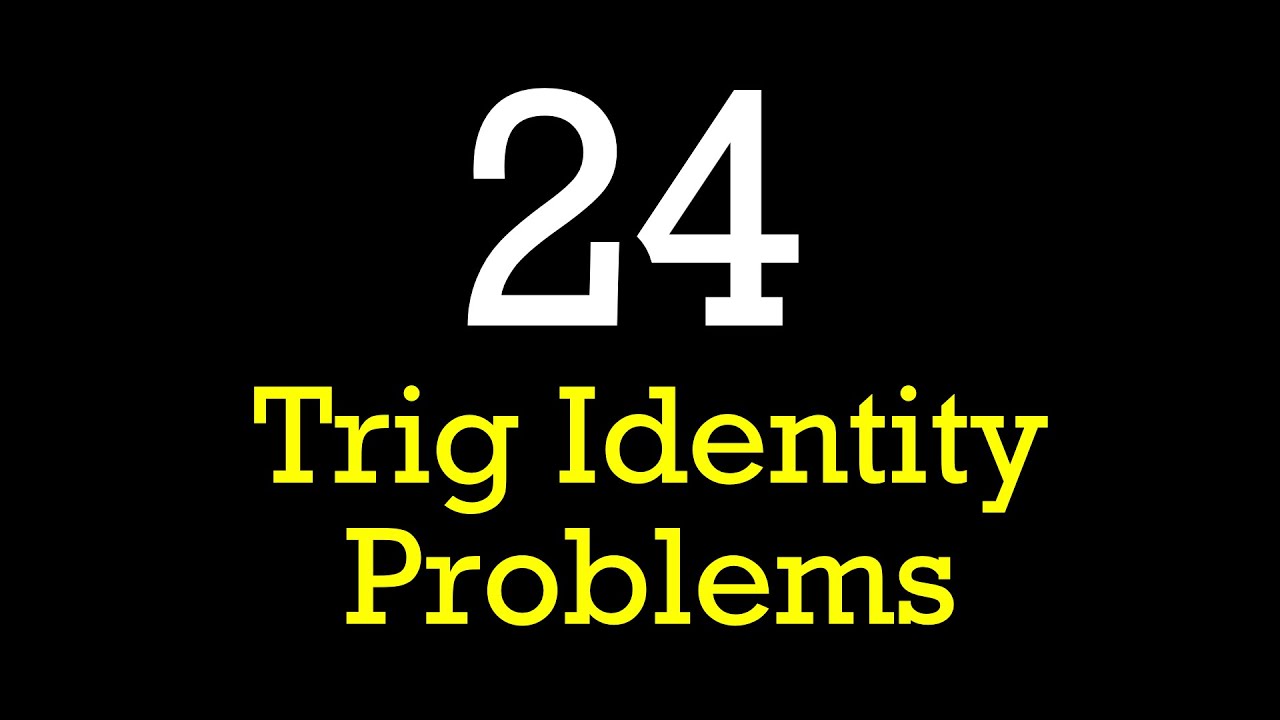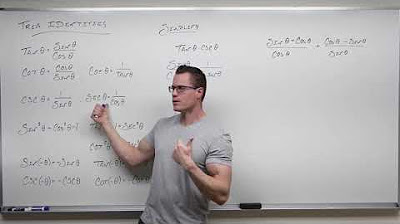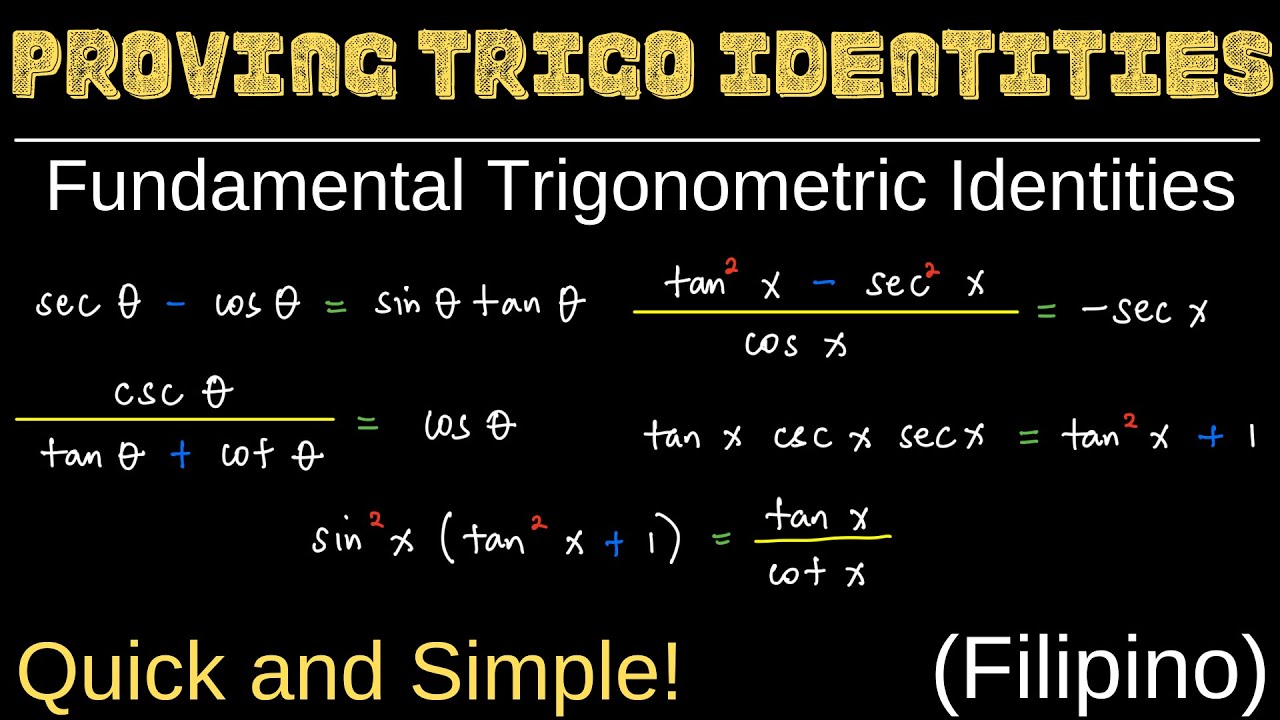Verifying Trigonometric Identities Easily - Strategy Explained (14 Examples)
TLDRThe video script is an engaging walkthrough of 14 challenging trigonometric identity problems aimed at enhancing the viewer's understanding and proficiency in trigonometry. The presenter encourages viewers to attempt each problem and share their solutions in the comments section. The script emphasizes a methodical approach to solving these problems, often starting with the more complex side and simplifying it to match the simpler side. It leverages the use of Pythagorean trig identities and the properties of trigonometric functions to guide the viewer through each step. The presenter also shares helpful tips, such as multiplying by the conjugate and factoring out common terms, to simplify the process. The script concludes with a prompt for viewers to engage with the content by commenting on their success rate with the problems, fostering a sense of community and learning.
Takeaways
- 📚 Start by identifying the more expanded or complicated side of the trigonometric identity and work towards simplifying it to match the more condensed side.
- 🧩 Use Pythagorean trig identities frequently, as they are helpful in simplifying and proving trigonometric identities.
- ✅ Replace cosecant squared minus 1 with cotangent squared to simplify expressions, leveraging the relationship between these functions.
- 🔄 Multiply by the conjugate when dealing with binomial expressions to help simplify and find a common denominator.
- 🤔 When stuck, convert back to sines and cosines, which are the basic building blocks of trigonometric functions.
- 📉 Factor out the greatest common factor in complex expressions to simplify the process of proving identities.
- 🔢 Memorize or have Pythagorean trig identities on hand, as they are often used in the process of identity verification.
- 🤓 Practice is key to getting better at verifying trigonometric identities, as recognizing patterns and substitutions improves with experience.
- 📝 Keep an eye on both sides of the identity while working, ensuring that you are moving towards the desired simplified form.
- 📉 Use the even and odd identities for negative angles, which can simplify expressions involving negative theta values.
- 📌 Always check your work by distributing back into the original expression after factoring to ensure accuracy.
Q & A
What is the general strategy for verifying trigonometric identities as described in the video?
-The general strategy for verifying trigonometric identities involves focusing on the more complex side of the identity and simplifying it to match the simpler side. This often includes using Pythagorean trigonometric identities and making substitutions to simplify the expression.
What are Pythagorean trigonometric identities and why are they frequently used in the video?
-Pythagorean trigonometric identities are equations that relate the squares of the basic trigonometric functions (sine, cosine, and tangent) to each other. These identities are frequently used because they simplify the manipulation of trigonometric expressions, especially when verifying identities.
What technique is suggested for handling trigonometric expressions involving squared terms?
-When dealing with trigonometric expressions involving squared terms, the video suggests using Pythagorean trigonometric identities to simplify these terms, often by substituting one function for another based on these identities.
How does the video explain the process of combining fractions in trigonometric identities?
-The video explains that combining fractions in trigonometric identities typically involves finding a common denominator for the fractions involved, then combining the numerators accordingly to simplify the expression to match the other side of the identity.
What is the significance of the cofunction identities mentioned in the video?
-Cofunction identities are used to relate trigonometric functions of complementary angles, such as sine and cosine, or tangent and cotangent. These identities are significant because they allow substitutions that can simplify the verification of identities involving angles like π/2 - θ.
Can you describe a scenario from the video where a trigonometric function of a negative angle is used, and how it's handled?
-In the video, trigonometric functions of negative angles are handled using even and odd identities. For example, sine is an odd function and cosine is an even function, which means the sine of a negative angle is the negative sine of the angle, and the cosine of a negative angle is the cosine of the angle. This property is used to simplify expressions involving negative angles.
What role do reciprocal identities play in verifying trigonometric identities as per the video?
-Reciprocal identities relate trigonometric functions to their reciprocals, such as sine and cosecant, or cosine and secant. These identities are crucial for simplifying expressions by allowing the substitution of one function for its reciprocal, thereby reducing the complexity of the identity being verified.
Why does the video emphasize practicing with different trigonometric identities?
-The video emphasizes practicing with different trigonometric identities to build familiarity and skill in manipulating these functions. This practice helps learners recognize patterns and develop strategies for simplifying and verifying identities more efficiently.
How is factoring used as a technique in verifying trigonometric identities in the video?
-Factoring is used as a technique to pull out common factors from terms in an expression, simplifying the rest of the expression. This is particularly useful in cases where the identity involves complex expressions that can be broken down into simpler, common components.
What advice does the video provide for those who find themselves stuck while trying to verify a trigonometric identity?
-The video advises that if you find yourself stuck while trying to verify a trigonometric identity, you should try making some type of substitution or simplification, even if it might not be immediately apparent if it will help. If the approach complicates the expression further, you can always revert to earlier steps and try a different tactic.
Outlines
🧮 Introduction to Verifying Trigonometric Identities
The video begins by challenging viewers to solve 14 trigonometric identity problems, encouraging engagement through comments. The instructor demonstrates solving the first problem involving cosecant and cosine functions. The approach emphasizes analyzing the complexity of each side of the identity and utilizing Pythagorean trig identities to simplify expressions. The example starts with converting cosecant squared theta minus one into cotangent squared, followed by further breakdowns and substitutions until proving that the expression simplifies to cosine squared theta.
🔍 Step-by-Step Solutions for Trigonometric Problems
This section delves deeper into trigonometric identities, tackling a complex problem involving sine and cosine. The instructor uses a systematic approach to combine terms into a single fraction, introduces a common denominator, and simplifies using algebraic manipulations. By breaking down the equation step by step, the problem is reduced to a simpler form that confirms the trigonometric identity. This detailed explanation not only solves the problem but also reinforces the methodical approach needed for verifying trigonometric identities.
📐 Advanced Techniques for Solving Trigonometric Identities
In this part, more complex trigonometric identities are addressed, using advanced techniques such as substituting with cofunctions and applying even and odd identities. The instructor provides clear explanations of the rationale behind each step, focusing on understanding the properties of trigonometric functions and how to manipulate them effectively. This section is crucial for viewers seeking to deepen their understanding of trigonometric identities and improve their problem-solving skills.
📏 Exploring Even and Odd Trigonometric Identities
This segment covers the concepts of even and odd functions within trigonometry, particularly focusing on sine and cosine. The instructor uses these identities to solve problems, emphasizing the importance of recognizing and applying these properties to simplify trigonometric equations. The detailed breakdown of each step helps viewers understand how to effectively use these identities to verify complex trigonometric equations.
🎓 Comprehensive Review and Factorization of Trigonometric Identities
The instructor reviews various trigonometric identities, employing techniques like factorization to simplify and prove the identities. Each example is carefully selected to demonstrate different strategies, such as pulling out common factors or applying Pythagorean identities in novel ways. This comprehensive review helps reinforce the viewers' understanding and ability to handle various trigonometric problems, encouraging them to think critically about each step of the solution process.
👋 Closing Remarks and Encouragement to Explore More
In the closing remarks, the instructor invites viewers to tackle more trigonometric identities in a subsequent video, aiming to further enhance their understanding and skills. This brief wrap-up not only summarizes the video's content but also motivates viewers to continue practicing and exploring the topic on their own, highlighting the continuous learning journey in mathematics.
Mindmap
Keywords
💡Verifying Trigonometric Identities
💡Pythagorean Trig Identities
💡Cosecant
💡Cotangent
💡Conjugate
💡Common Denominator
💡Factorization
💡Reciprocal Identities
💡Identity Verification
💡Pythagorean Theorem
Highlights
Introduction to a trigonometric identity verification challenge with 14 problems.
Demonstration of simplifying cosecant squared theta using Pythagorean identities.
Explanation of converting cotangent squared into cosine squared over sine squared.
Step-by-step process of simplifying complex trigonometric expressions by substituting identities.
Technique of multiplying numerators and denominators to simplify trigonometric fractions.
Use of binomial multiplication to simplify expressions involving cosine and sine.
Illustration of verifying an identity by combining fractions and reducing them.
Example of substituting cosecant squared with cotangent squared minus one.
Strategy of making identical substitutions to simplify and prove trigonometric identities.
Encouragement for persistence in solving challenging trigonometric proofs.
Introduction of a method involving the multiplication by conjugates to simplify expressions.
Conversion of cotangent of pi/2 minus theta using cofunction identities.
Verification of identities involving even and odd functions for negative angles.
Application of greatest common factor (GCF) extraction in trigonometric identities.
Final challenge and invitation to further explore trigonometric identities in additional content.
Transcripts
Browse More Related Video

How to Prove Trigonometric Identities (Precalculus - Trigonometry 24)

Ultimate trig identity problem study guide!

Identities Grade 11: Introduction and practice

Verifying Trigonometric Identities

Introduction to Using Trigonometric Identities (Precalculus - Trigonometry 23)

Proving Trigonometric Identities | Fundamental Trigonometric Identities | Formulas | Part 2
5.0 / 5 (0 votes)
Thanks for rating: